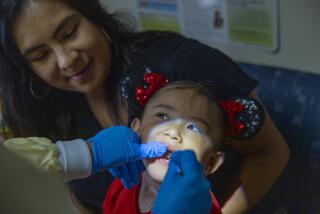A Controversy With Real Teeth to It
- Share via
Remember when braces went hand in hand with pimples? Kids got them at about the same awkward time.
Well, today’s generation of youths destined for braces is more likely to get them while the tooth fairy is still leaving them money. And they’ll likely get them twice.
In the jargon of dentistry, it’s called “two-phase orthodontia,” which means you get dental hardware twice, once in early grade school and again in middle school. Today as many as 80% of children go through two-phase orthodontia, according to some estimates. Though the two-step process costs more in time and dollars, proponents believe it achieves better results.
But it also raises questions: Are two phases really necessary? And--considering some kids as young as 2 are wearing dental appliances--how early is too early for braces?
Welcome to a raging debate in orthodontia today. “Ask a roomful of dentists and orthodontists what the best age is to start treating kids and you’ll get as many answers as you have practitioners,” says Dr. Paul Reggiardo, a Huntington Beach pediatric dentist and a trustee of the American Academy of Pediatric Dentistry.
Some dentists and orthodontists say too many in their profession overprescribe early orthodontia. The motivators are greed and parental vanity, they charge.
Even those dentists, however, say that in some select cases, repositioning jaws before permanent teeth come in is the best alternative.
“We’re talking about two concepts here,” says Dr. Donald F. Duperon, president of the California Society of Pediatric Dentists, and professor and chairman of pediatric dentistry at UCLA, “orthodontics and dental facial orthopedics.”
Orthodontics involves the moving and aligning of teeth; dental facial orthopedics involves moving bones. Manipulating bones works only while bones are growing, when you can harness that growth and use it as an ally to create the shape you want. After kids finish puberty--usually between 13 and 15, girls on the earlier side--that window of opportunity closes.
But since you can’t straighten permanent teeth before they’re in, many experts prefer to wait for the magic window--when kids are 11 or 12--to straighten bones and teeth at once. Others say get the bones right sooner, then come back and straighten permanent teeth later. Teens or adults who opt for orthodontia don’t have bone growth working for them so more often need teeth pulled or jaw surgery.
Thanks to evolution, the need for orthodontia and tooth extraction is at an all-time high. Fossil records show that human jaws are shrinking faster than the number and size of people’s teeth. As a result, more than half the population needs orthodontia, though only 37% of those who need braces actually get them. Who does depends heavily on household income and demographics.
“I heard recommendations on all sides,” says Julia Copeland, referring to the opinions about orthodontia for her son, then age 9. Although all specialists agreed he needed treatment for his overbite and crowding, some recommended starting immediately and others said wait. “I opted to start early because I wanted to avoid . . . what happened to me.”
Copeland had braces in college and four permanent teeth pulled.
Today the American Orthodontist Assn. recommends that kids see an orthodontist by age 7. However, “more are having treatment done at that time than should be,” says Dr. Alan Bloore, an orthodontist in private practice in Beverly Hills. “Of the patients receiving two-phase treatment, only about one-third actually need it.”
Early Correction for Bite Problems
The wild card is jaw growth. No one can predict how much a jaw will grow and how crowded teeth will ultimately be; the younger the patient, the less accurate the prediction. Bite pattern problems, however, such as overbites, under-bites and cross-bites, usually remain constant and can be relieved with early correction.
“Kids go through an ugly duckling phase,” Bloore adds. Between the ages of 7 and 10 permanent teeth come into developing jaws and are usually in poor position. Instead of waiting for improvement, many parents rush to the orthodontist. Or they see a dentist who scares them by saying, “If you don’t do this now, you’ll have to remove permanent teeth.” Some get correction for problems that would have taken care of themselves.
But, says Dr. Conrad Sack, who teaches dental orthopedics at UCLA School of Dentistry, parents opt for two-phase treatment less out of fear and more to gain control.
“Parents today want to be proactive, not reactive,” he says.
Like Sandy McReynolds of Orange, who says, “I don’t believe in putting my kids through the discomfort of ugly teeth. Adolescence will be tough enough.”
Her oldest daughter, now 10, started wearing a dental appliance to straighten crooked teeth when she was 7, and she’s “almost done.” Having straight teeth and removable braces were also desirable, she says, because her two daughters do television commercials.
Besides parents wanting their kids to look good and hoping to spare them torment, another force driving the increased use of early dental orthopedics is money.
As in any business, dental practitioners compete with one another. If a pediatric dentist can secure a patient before the orthodontist, it’s his gain. If he waits, he may lose the business. Plus, an early start means parents pay more money over more time. When early intervention results in two-phases (not all do), parents can add $1,000 to $2,000 to the cost of one-step orthodontia, which typically runs between $3,500 and $6,000.
“Ninety-five percent of practitioners are ethical,” says Duperon, “but, as in any field, you have people just out for the money.”
Studies Show No Benefit From Early Intervention
Meanwhile, Bloore notes, “nothing in the literature says we should have fixed these problems sooner.” In two separate university-based studies comparing one-phase with two-phase treatments, researchers found that starting appliances early in general “conferred no obvious measurable benefit.”
Still, Sack, who is also president of the American Society of Dentistry for Children, doesn’t believe two-phase treatment is overprescribed.
“I’m a big advocate of early intervention. When you get in and fix problems early, you achieve a better facial aesthetic and function sooner. You may eliminate the need for braces or reduce the time a child needs to wear them. You often eliminate the need for extraction and possibly surgery and wind up with better-looking faces and jaws.”
Proponents of one-step treatment, however, argue that it’s cheaper, faster and works.
The children who do benefit from early intervention are those with an extreme overbite, in which top teeth stick out so far that the children risk chipping them, injuring themselves or being teased; a severe under-bite, in which the top front teeth fit behind the lower teeth; or a cross-bite, in which back teeth fit so poorly the jaw slides sideways.
Sack sometimes treats these problems when children are as young as 3 but adds that the ideal age for dental facial work is between 6 and 9. Duperon also believes in correcting certain problems as soon as they’re found and has corrected cross-bites in kids as young as 2.
Experts do, however, agree on this: Dental orthopedics isn’t something the average dentist should do. If your family dentist wants to do dental orthopedics, get a second opinion from a specialist.
“The general population of dentists gets only a smattering of facial bone growth and orthodontia in school,” Sack says. “Pediatric dentists, on the other hand, get in-depth training about the facial bone growth of kids, and orthodontists are the ultimate specialists in this area.”
If you go ahead with treatment, be sure your practitioner gives you a definite time frame and offers services at a fixed cost, not so much per month. And don’t hesitate to ask tough questions.
The real question parents need to ask, Bloore says, is this: If this isn’t done now, and I come back when my child is 10, can it still be fixed and can it be fixed to the same degree? “Sometimes, no, it can’t wait is a valid answer. But most of the time the braces can wait.”






